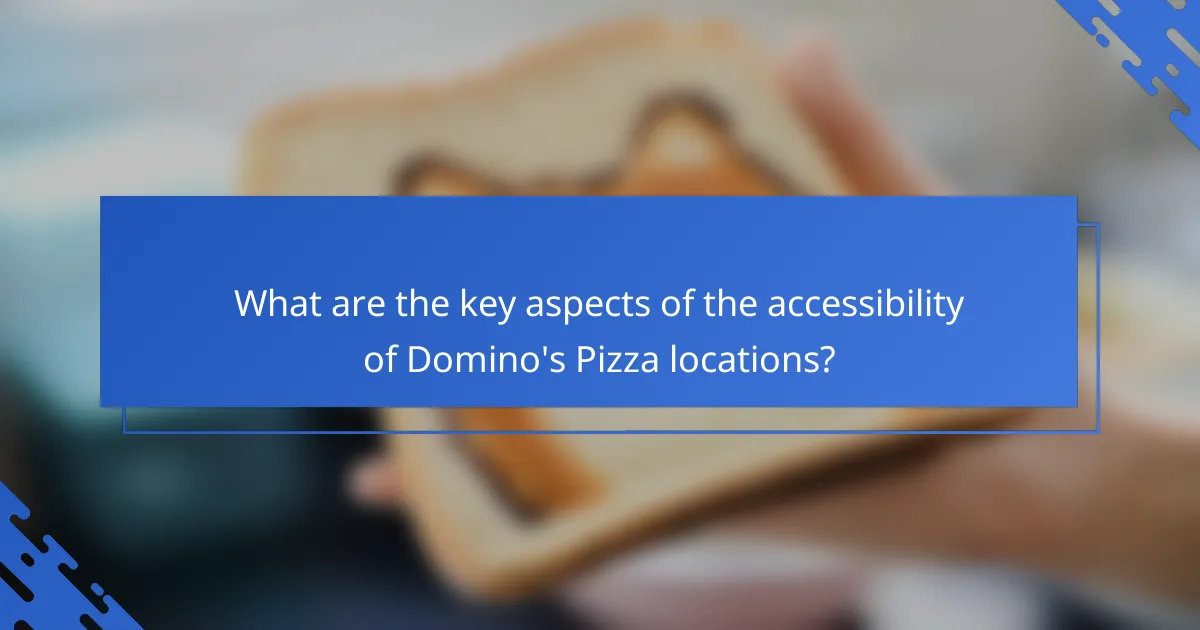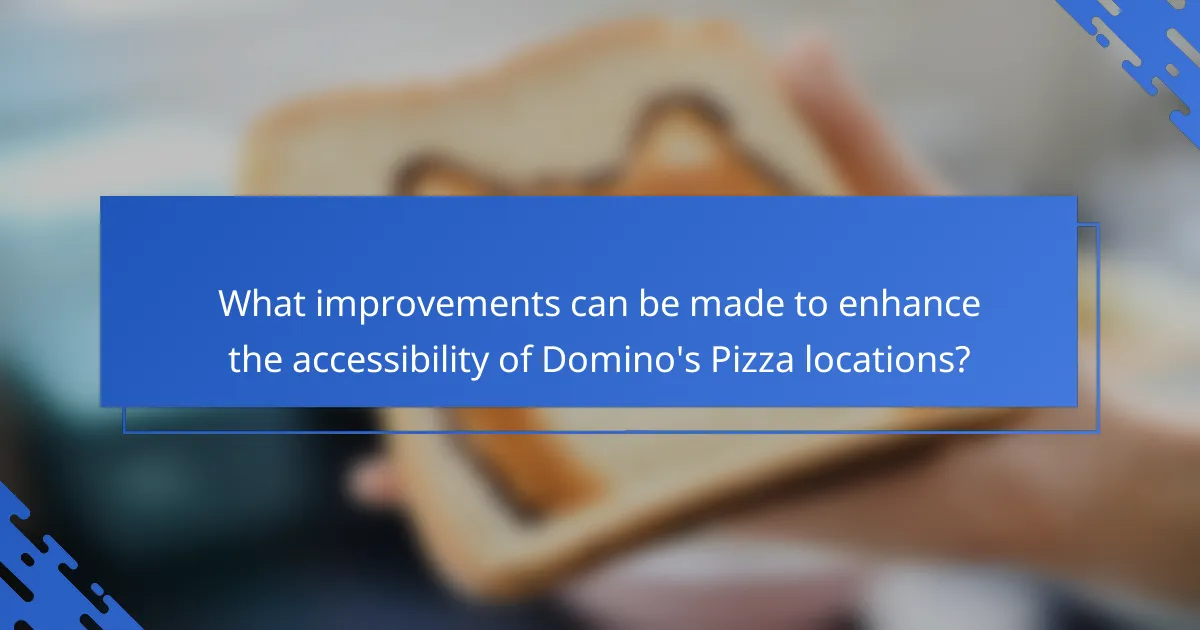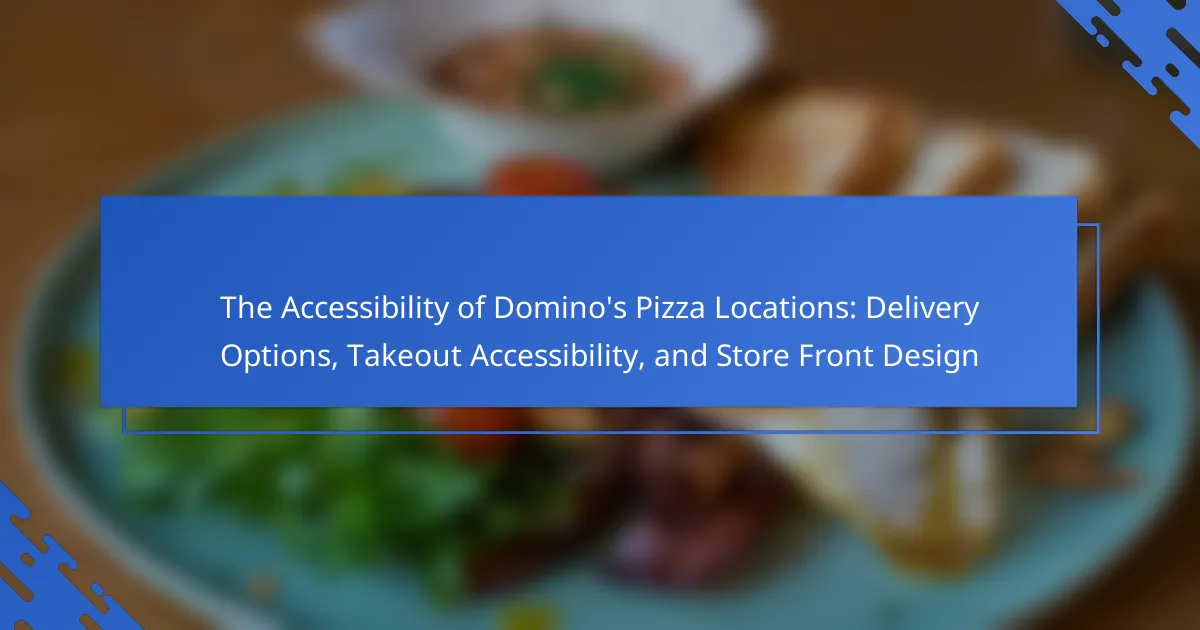The article focuses on the accessibility of Domino’s Pizza locations, highlighting key aspects such as location convenience, delivery options, and store layout. It details how many Domino’s stores are strategically situated in urban and suburban areas to enhance customer access, along with various delivery methods like online ordering and contactless delivery. The article also emphasizes the design features of storefronts, including accessible entrances, clear signage, and designated parking, which collectively improve the experience for all customers, including those with disabilities. Suggestions for further enhancements, such as staff training and tactile paving, are discussed to promote a more inclusive environment.

What are the key aspects of the accessibility of Domino’s Pizza locations?
The key aspects of the accessibility of Domino’s Pizza locations include location convenience, delivery options, and store layout. Most Domino’s locations are strategically placed in urban and suburban areas for easy access. They offer various delivery options, including online ordering and contactless delivery. Storefront designs typically feature accessible entrances and clear signage. Many locations provide designated parking for quick pickup. Additionally, some stores are equipped with ramps for wheelchair access. These features enhance the overall accessibility for customers.
How do delivery options enhance accessibility for customers?
Delivery options enhance accessibility for customers by providing convenience and flexibility. Customers can order from home, eliminating the need for transportation. This is particularly beneficial for individuals with mobility challenges. Delivery services extend reach to customers in remote or underserved areas. Research indicates that 70% of consumers prefer delivery for its ease. Additionally, delivery options can accommodate diverse schedules, allowing customers to receive orders at their convenience. This increased accessibility can lead to higher customer satisfaction and loyalty.
What types of delivery services does Domino’s offer?
Domino’s offers several types of delivery services. These include traditional delivery, where drivers bring orders directly to customers’ locations. They also provide contactless delivery, ensuring safety by minimizing physical interaction. Additionally, Domino’s features a pizza tracker that allows customers to monitor their order status in real-time. The delivery service is available through their website and mobile app, enhancing convenience. Domino’s operates in various locations, ensuring widespread accessibility for customers. The company has adapted its delivery methods to meet customer needs, particularly during the pandemic.
How does technology influence Domino’s delivery accessibility?
Technology enhances Domino’s delivery accessibility through various digital platforms and innovations. The Domino’s app allows customers to place orders easily, increasing convenience. Real-time tracking features provide customers with updates on their delivery status. This transparency boosts customer satisfaction and trust. Additionally, the integration of AI optimizes delivery routes, reducing wait times. Online payment options streamline the ordering process, making it faster. Furthermore, partnerships with third-party delivery services expand reach to more customers. According to Domino’s, over 60% of their sales come from digital orders, highlighting the impact of technology.
What factors contribute to takeout accessibility at Domino’s?
Takeout accessibility at Domino’s is influenced by several key factors. These include location proximity, store layout, and order efficiency. Proximity ensures customers can easily reach the store. A well-designed store layout facilitates quick pick-up. Efficient order systems, such as online and mobile ordering, streamline the process. Additionally, extended operating hours improve accessibility for customers. Promotions and special offers may also encourage takeout orders. Each of these factors contributes to a seamless takeout experience at Domino’s.
How do store hours impact takeout options?
Store hours significantly impact takeout options by determining when customers can place orders. Limited hours restrict customer access to takeout services. For instance, if a store closes early, customers miss opportunities for late-night meals. Conversely, extended hours increase takeout accessibility for those with varied schedules. Research indicates that restaurants with longer operating hours see higher customer traffic. This correlation suggests that flexible store hours cater to diverse consumer needs. Additionally, specific hours can align with peak demand times, optimizing service efficiency. Thus, store hours directly influence the availability and convenience of takeout options.
What measures are in place for easy takeout at Domino’s locations?
Domino’s locations implement several measures for easy takeout. They offer designated takeout areas for quick pickup. Customers can place orders online or via the app for convenience. Many locations feature a drive-thru for added accessibility. The stores are designed with clear signage to guide customers. Staff are trained to expedite the takeout process. Additionally, some locations provide contactless pickup options. These measures enhance the overall efficiency of takeout services at Domino’s.
How does storefront design affect customer accessibility?
Storefront design significantly affects customer accessibility by influencing entry ease and navigation. Features like ramps, wide doorways, and clear signage facilitate access for all customers. For instance, a study by the American Disabilities Act indicates that well-designed entrances improve accessibility for individuals with mobility challenges. Additionally, visual elements such as contrasting colors enhance wayfinding for visually impaired customers. Properly designed storefronts also accommodate strollers and carts, thus broadening customer access. Overall, effective storefront design fosters an inclusive environment, promoting higher customer satisfaction and engagement.
What design elements are prioritized for accessibility in Domino’s stores?
Domino’s stores prioritize several design elements for accessibility. These include wheelchair-accessible entrances and pathways. Stores often feature designated parking spaces for individuals with disabilities. Interior layouts are designed to allow easy navigation for customers using mobility aids. Additionally, accessible ordering kiosks are available in many locations. Staff training on assisting customers with disabilities is also emphasized. Clear signage with large fonts aids visibility for all customers. These design choices align with ADA compliance standards.
How does storefront layout facilitate customer navigation?
Storefront layout facilitates customer navigation by creating an intuitive flow through the space. Clear pathways guide customers to key areas like ordering counters and pickup zones. Strategic placement of signage enhances visibility and directs attention. Organized product displays allow for easy browsing and quick decision-making. Research indicates that well-designed layouts can increase customer satisfaction and reduce shopping time. For instance, a study by the Journal of Retailing found that effective store layouts can boost sales by up to 20%. In the context of Domino’s Pizza, a logical layout ensures customers can quickly find the takeout area or delivery options, enhancing overall accessibility.

In what ways do Domino’s delivery options cater to diverse customer needs?
Domino’s delivery options cater to diverse customer needs through multiple channels and features. They offer standard delivery, carryout, and contactless delivery options. Customers can choose delivery to their doorstep or opt for carryout to save on delivery fees. The contactless delivery option ensures safety during health concerns, allowing customers to receive their orders without direct contact. Domino’s also provides real-time tracking of orders via their app, enhancing customer experience. Additionally, they have a range of payment options, including cash, credit, and digital wallets, accommodating various preferences. The ability to customize orders further meets individual dietary needs and preferences. These features collectively ensure that Domino’s delivery services are accessible and convenient for a wide range of customers.
What special services are available for customers with disabilities?
Domino’s Pizza offers several special services for customers with disabilities. These services include accessible store entrances and parking. Many locations provide wheelchair ramps and designated parking spaces. Additionally, employees are trained to assist customers with various needs. Domino’s also offers online ordering features that enhance accessibility. These features include screen reader compatibility and easy navigation for users with visual impairments. The company aims to ensure that all customers can enjoy their services comfortably.
How does Domino’s ensure compliance with accessibility standards?
Domino’s ensures compliance with accessibility standards by adhering to the Americans with Disabilities Act (ADA). The company evaluates its restaurant designs to meet ADA guidelines. This includes accessible entrances, restrooms, and parking spaces. Domino’s also trains staff on accessibility awareness and customer service. They regularly assess their locations for compliance updates. Feedback from customers with disabilities is actively sought to improve services. Domino’s commitment to accessibility is reflected in their corporate policies and community engagement efforts.
What feedback mechanisms are in place for customers to report accessibility issues?
Customers can report accessibility issues through multiple feedback mechanisms at Domino’s Pizza. These include a dedicated customer service phone line and an online contact form on their website. Customers can also use social media platforms to voice their concerns. Additionally, in-store feedback forms may be available for immediate reporting. Domino’s aims to address accessibility issues promptly based on customer input. This approach ensures that feedback is received and processed effectively, supporting ongoing improvements in accessibility.
How do delivery and takeout options compare in terms of accessibility?
Delivery options generally provide greater accessibility compared to takeout options. Delivery allows customers to receive food at their location, eliminating the need to travel. This is particularly beneficial for individuals with mobility challenges or those without transportation. According to a study by the National Restaurant Association, 60% of consumers prefer delivery for its convenience. In contrast, takeout requires customers to visit the restaurant, which can be a barrier for some. Accessibility features at locations, such as parking and entryways, can vary and may not always accommodate all customers effectively. Therefore, delivery options are often the more accessible choice for a wider audience.
What are the advantages of takeout over delivery for certain customers?
Takeout offers several advantages over delivery for certain customers. First, takeout allows for immediate pickup, eliminating wait times associated with delivery. Customers can control their order timing by choosing when to pick up their food. Second, takeout reduces the risk of food temperature loss during transit. Studies show that food often cools down during delivery, affecting freshness. Third, takeout avoids delivery fees, making it a cost-effective option for budget-conscious customers. Additionally, customers can inspect their order before leaving the restaurant, ensuring accuracy. Lastly, takeout provides an opportunity for social interaction at the restaurant, enhancing the overall dining experience.
How does customer preference influence Domino’s service offerings?
Customer preference significantly influences Domino’s service offerings. The company adapts its menu and services based on customer feedback and market trends. For instance, Domino’s has expanded its delivery options to include contactless delivery in response to customer safety concerns. Additionally, they have introduced a variety of crust options and toppings to cater to diverse tastes. Domino’s also utilizes data analytics to track customer ordering patterns. This data helps them optimize their menu and promotional strategies. The introduction of online ordering and mobile app features aligns with customer demand for convenience. According to a 2021 survey, 60% of customers prefer ordering online rather than in-store. This trend has led Domino’s to enhance its digital platforms. Overall, customer preferences drive the evolution of Domino’s service offerings to meet changing demands.

What improvements can be made to enhance the accessibility of Domino’s Pizza locations?
Enhancements to the accessibility of Domino’s Pizza locations can include installing ramps for wheelchair access. This would ensure that individuals with mobility challenges can enter the store easily. Another improvement is to provide clear signage indicating accessible entrances and facilities. This helps customers identify accessible options quickly.
Additionally, staff training on assisting customers with disabilities can improve service quality. Implementing tactile paving can guide visually impaired customers to the entrance. Offering online ordering with customizable options can also enhance accessibility for those with specific dietary needs. Lastly, ensuring adequate parking for accessible vehicles is crucial for convenience. These measures collectively promote a more inclusive environment for all customers.
What are the current challenges faced in delivery and takeout accessibility?
Current challenges in delivery and takeout accessibility include logistical inefficiencies and technology barriers. Many delivery services struggle with route optimization, leading to delays. Additionally, not all customers have access to reliable internet or smartphones for ordering. Accessibility issues also arise from physical barriers at store locations, such as inadequate parking or entryways. Furthermore, some areas face limited service availability, impacting customer choices. According to a 2022 survey, 30% of respondents reported difficulties in accessing delivery services due to these factors. These challenges hinder the overall customer experience in takeout and delivery options.
How can technology be leveraged to improve service accessibility?
Technology can be leveraged to improve service accessibility by implementing online ordering systems. These systems allow customers to place orders from home, increasing convenience. Mobile apps enhance this by offering features like location tracking and estimated delivery times. Voice-activated assistants can facilitate ordering for those with disabilities. Furthermore, digital menus can be designed for easy readability and navigation. Accessibility features, such as screen readers, can assist visually impaired customers. According to a 2021 study by the Pew Research Center, 85% of Americans own a smartphone, underscoring the potential reach of mobile solutions. These technologies collectively ensure that all customers can access services effectively.
What role do customer suggestions play in enhancing accessibility features?
Customer suggestions play a crucial role in enhancing accessibility features. They provide firsthand insights into the needs of users with disabilities. Feedback from customers can highlight specific barriers they encounter. This information helps businesses identify areas for improvement. For example, suggestions can lead to modifications in store layout or delivery options. Implementing these changes can significantly improve the overall customer experience. Research indicates that companies that actively seek customer feedback see increased satisfaction and loyalty. Therefore, integrating customer suggestions is essential for effective accessibility enhancements.
What best practices can Domino’s adopt for better accessibility?
Domino’s can adopt several best practices for better accessibility. First, they should ensure that all locations comply with ADA (Americans with Disabilities Act) standards. This includes having accessible parking, entrances, and restrooms. Second, they can implement user-friendly online ordering systems that cater to individuals with disabilities. This includes screen reader compatibility and easy navigation. Third, training staff on accessibility awareness can enhance customer service for those with disabilities. Fourth, providing alternative delivery options, such as contactless delivery, can accommodate various needs. Lastly, soliciting feedback from customers with disabilities can help identify specific areas for improvement. These practices will create a more inclusive environment for all customers.
How can staff training improve customer service related to accessibility?
Staff training can significantly improve customer service related to accessibility by equipping employees with essential knowledge and skills. Training programs can educate staff about the specific needs of customers with disabilities. This includes understanding various accessibility tools and resources available to assist these customers.
For instance, training can cover how to effectively communicate with individuals who have hearing or speech impairments. It can also teach staff how to navigate physical spaces to assist customers with mobility challenges. According to the U.S. Department of Justice, businesses that provide appropriate training can enhance the overall customer experience for individuals with disabilities.
Moreover, trained staff can identify and resolve accessibility issues promptly. This proactive approach can lead to higher customer satisfaction rates. Customer feedback often highlights the importance of knowledgeable staff in creating an inclusive environment. Thus, effective training not only improves service but also fosters a positive reputation for the business.
What community partnerships can enhance Domino’s outreach for accessibility?
Collaborating with local disability advocacy organizations can enhance Domino’s outreach for accessibility. These partnerships can provide valuable insights into the needs of individuals with disabilities. Engaging with organizations such as the National Federation of the Blind can help Domino’s improve delivery services for visually impaired customers. Partnering with local chapters of the American Association of People with Disabilities can facilitate community events focused on accessibility awareness. Collaborations with schools for special education can foster inclusive hiring practices. Additionally, working with local government agencies can help Domino’s align with regulations and accessibility standards. These partnerships can ultimately lead to improved customer experiences and increased brand loyalty among diverse communities.
The main entity of this article is Domino’s Pizza, focusing on its accessibility features across delivery options, takeout accessibility, and storefront design. Key aspects discussed include the strategic location of stores, various delivery methods such as contactless and traditional options, and the design elements that enhance customer navigation and convenience. The article also covers the impact of technology on accessibility, special services for customers with disabilities, and best practices for improving the overall customer experience. Additionally, it highlights the importance of customer feedback and community partnerships in enhancing accessibility measures at Domino’s locations.
